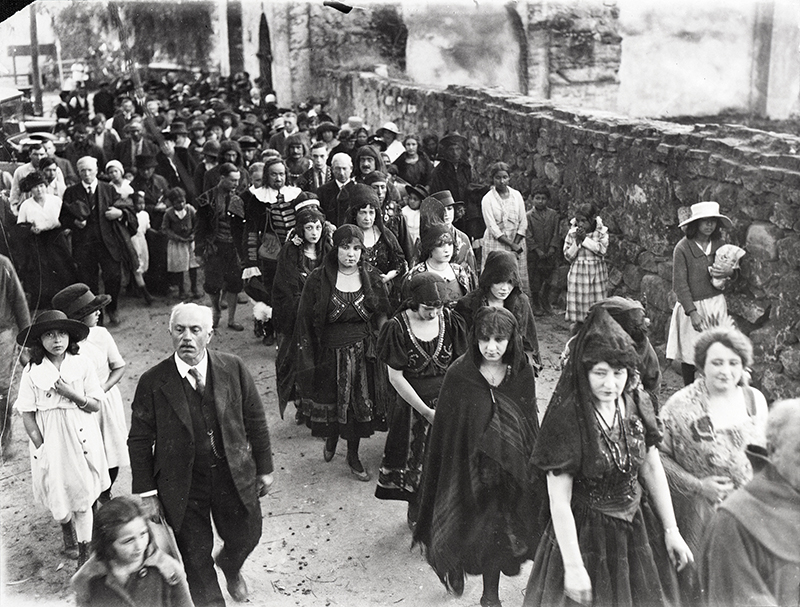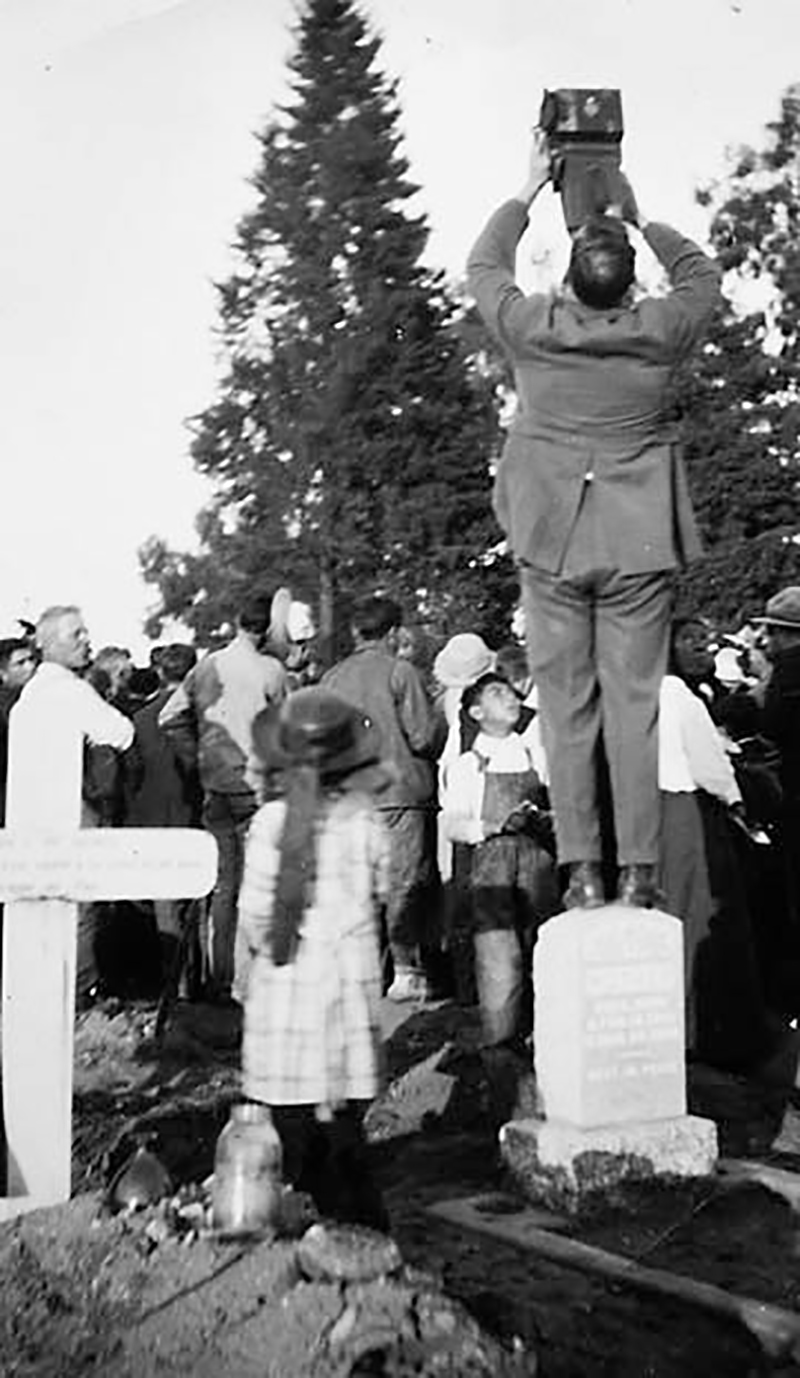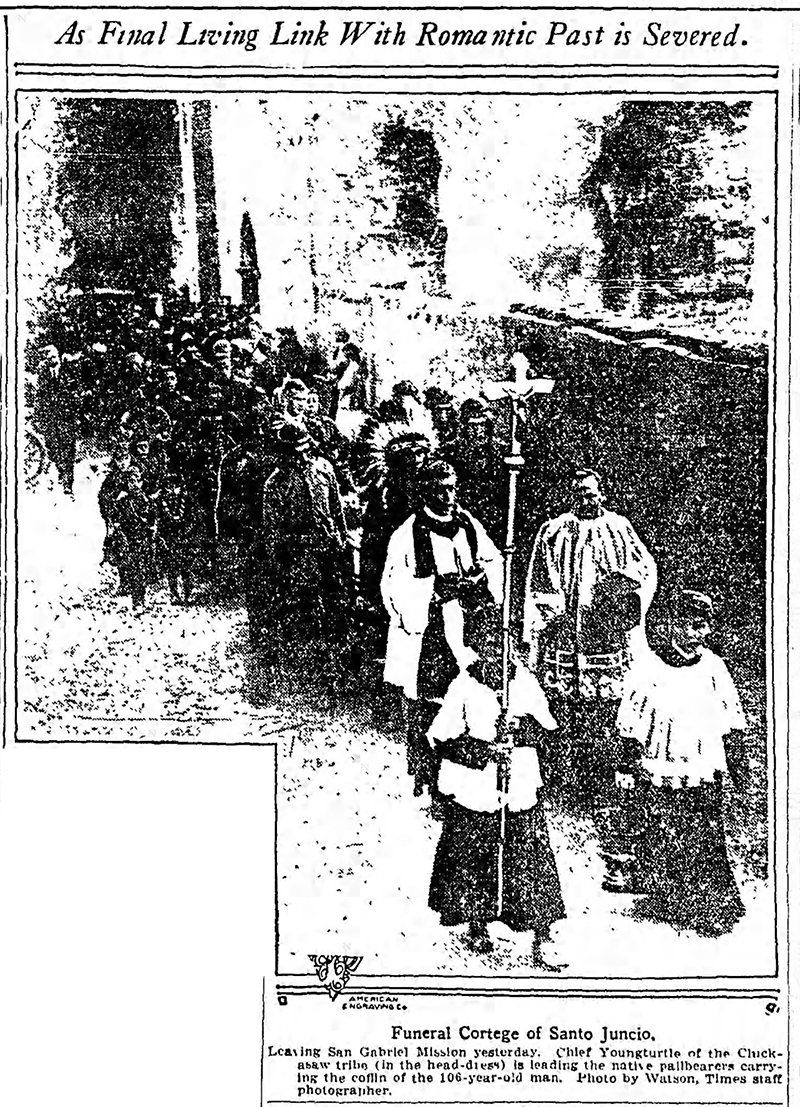|
|


Click image to enlarge
Funeral service for Santos Juncos at the San Gabriel Mission, February 11, 1912. Shown are performers in the Mission Play. Photo by George Watson for the Los Angeles Times. 4x5-inch negative from the Watson Archive. The photographer's cutline reads: "Large crowd of Indian & Hispanic mourners follow the casket of Santa Juncio [sic], last of the San Gabriel Indians."
JOSÉ DE LOS SANTOS JUNCOS was heralded as the "last of his race" when he died in 1921 at a reported age of 106. The reportage (see below) was consistent with the popular mythos of the "vanishing Indian" as the hallmark of a gloriously romantic past teeming with friendly priests and unicorns, when in fact the only people who vanished were the individual "mission" Indians who had known Spanish subjection a full century earlier. Ironically, the same reporters note that Santos Juncos' pallbearers were "lineal descendants" of San Gabriel Mission-born Indians. Santos Junco, aka Santo Juncio, saw tremendous changes in Southern California during a lifetime that spanned the periods of Spanish, Mexican and American rule. Luckily, in his final years he shared his experiences and knowledge of native words and phrases with ethnographer-linguist John Peabody Harrington. Santos Juncos was probably born at or near the San Gabriel Mission, but he was actually Juaneño (Acjachemen). His mother, Maria Valediana, and his father, Jose Engenio Juncos, were born at Mission San Juan Capistrano and were of Juaneño descent1. And they had medicine. Santos Juncos might have followed in his parents' footsteps had they not stunted his spiritual growth. (See below.) Santos Juncos lived out his final 40 years at the San Gabriel Mission. He spoke Gabrielino and was more familiar with Gabrielino lifeways than with those of his southern neighbors2. As for his birth year, the Los Angeles Times death notice gives the date of 1815 as "authenticated by the mission records," although we haven't yet identified him in the ECPP database3. Harrington quotes another informant who says Santos Juncos was born in 1820 4. Elsewhere, Harrington suggests the late 1820s5. As a younger man, Santos Juncos worked for and lived in the household of a Los Angeles attorney known as Col. Kewen. Later, Harrington would frequently refer to Santos Juncos as "Kewen" or the phonetic "Kuhn" (or simply "informant") in his field notes. This is not unusual; California Indians often took the surname of their post-mission-period Euro-American employers, with whom they typically lived. Santos Juncos also lived for a time with the family of Don Benito Wilson and sheared sheep at various Southland ranches, including on Santa Cruz Island6. From 1914-1918 Santos Juncos, then at least approaching 100 years in age, shared his memories of language and culture with Harrington. Of local interest, he remembered there being Indians at Piru, Camulos and Tejon, and he came into contact with other Indians across a wide region from Santa Barbara to San Diego. The following is a sampling from Harrington's field notes from his interviews with Santos Juncos7. Parentheses () are Harrington's; brackets [] are ours. For legibility, when Harrington wrote "Inf.," we have changed it to "Informant." Ditto with "Ind." for "Indian" and "mtn" for "mountain." Also, Harrington wrote "S." for "San" (as in San Fernando) and for "Santa" (as in Santa Barbara); and he usually wrote "G" for Gabrielino, "S.G." for San Gabriel, "F" for Fernandeño, "Cal." for California, and various abbreviations for Joaquin Murrieta. We have spelled them out.
Many more Santos stories await discovery in Harrington's field notes. One important story not reproduced here, due to its sheer length and Harrington's keyboard-breaking transliterations, is a tale explaining the arrival of a horrible disease (probably smallpox) that decimated the Indian popoulation at the missions. In short, one day the Indian capitan hired shamans from the Channel Islands — and paid them in abalones — to use magic to kill his enemies (certain other Indians). He admonished them to be careful not to kill his own family members in the process. The plan backfired. — Leon Worden 2017
1. McCawley 1996:15. 2. Ibid.:16. 3. Early California Population Project, The Huntington Library (Huntington.org). 4. The Papers of John P. Harrington in the Smithsonian Institution 1907-1957, Volume 3, Microfilm: "A Guide to the Field Notes: Native American History, Language and Culture of Southern California/Basin." Reel 104 (Gabrielino), Pg. 29. 5. McCawley: ibid. 6. Ibid.; and Harrington Papers, op. cit., Reels 104 and 105. 7. Harrington Papers: ibid.
Race Vanishes As Juncio Dies.
San Gabriel Mission Indian Had Reached 106th Year.
Los Angeles Times | Thursday, February 10, 1921.
The death of Santo Juncio at the San Gabriel Mission yesterday afternoon marked the passing of the last of a vanished race. With him died the last vestige of personal remembrance of the golden age of the California missions — Juncio, who had reached the age of 106 years, authenticated by the mission records, takes with him to the happy hunting ground the last voice which told at first hand the story of the State's most romantic period. He was born at the old mission in 1815, spent his youth and young manhood there when the institution was prospering, and engaged in many of the activities which the fathers taught the red men and which made of the mission Indians a superior specimen of their race. After the Mexican War when California became a part of the United States, Juncio left the mission and for years made his home in the then little town of Los Angeles.
Near Family Bones.
He applied himself to several of the arts he had learned in the mission days, and finally became part of the household of Col. Kuehn, where he lived for some time until he went to reside with the [Benito] Wilson family, where he stayed until it was thought his days of usefulness were over, when he again returned to the old mission, to be, as he expressed it, "near the bones of my forefathers," the last years of his life. His days were in no manner drawing to a close, however, as his return to San Gabriel was forty years ago. After his return, he did little but dream of the days of the past and was one of the attractions of the mission town, being able at times to relate hitherto forgotten tales and bring to light what might have been forgotten history. Among the notable events of his life was a day spent with John Burroughs during the visit of the naturalist to California last winter, when Mr. Burroughs remarked that it made him feel like a youth when, at the age of 82, he could meet and converse with a really old man. Mr. Burroughs had an engagement to repeat the visit today, but instead of meeting, his old friend will be one of the group who will hear the mission priests chant his funeral service. Juncio, despite his advanced years, had been in good health all his life, and approached the end with no suffering or any noticeable ailment. He was around the city Tuesday as usual and remained abed yesterday morning, "because he was tired." The end came while he slept. Funeral services will be conducted this morning at the old mission [sic; services were held Feb. 11], and the body will be laid to rest in the old cemetery, where his forefathers were buried in ground consecrated by the early mission fathers.
Rare Honor to Last of Race.
Santo Juncio Borne to Grave with Pomp, Ceremony.
Los Angeles Times | Saturday, February 12, 1921.
The bells of San Gabriel Mission which called together a faithful band of Indian converts more than a hundred years ago that they might witness the baptism of Santo Juncio, yesterday tolled the call which bade 2,000 residents of the valley gather at the same house of worship to add their presence as a last tribute at his funeral service. Juncio was born in the mission 106 years ago. He passed his entire life within sight of the same mountains and within a radius of twenty miles of his birth [incorrect; see above — Ed.], and yesterday was accorded the funeral rites of the Catholic Church before the same altar from which his baptismal ceremony was read a century before. [The church's current (2017) published history says the altar is original — Ed.] His passing marked the severing of the last living tie between the romantic past and the present. He was the last of 16,000 of his race won from savagery to Christianity through the efforts of the mission fathers and the last who could tell from personal experiences the story of the California missions when they were in the their glory.
Braves Carry Coffin.
The death of Santo, as he was best known, was an event to those who have learned the story of the missions, and his funeral was attended with pomp and ceremony seldom, if ever, before accorded an Indian by members of the white race. The coffin containing the remains was carried from the street into the narrow aisle of the historic old church by six young Indians, lineal descendants of the men who, like Santo, had been born within the mission walls. Part of the Catholic burial service, including prayers and the office for the dead, was read by Father Rafael Serrano, one of the priests at San Gabriel. The little house of worship was filled to overflowing and a crowd waited outside while the short ceremony was in progress. At the conclusion of the services within the church the cortege moved down the wide walk leading to the mission burial ground where the ancestors of this man, the last of his race [sic; see preceding paragraph], are buried. Preceding the casket were altar boys and the officiating clergymen, and following them, as guard of honor, was Chief Youngturtle of the Chickasaw tribe [this is likely Chief Lux-Oshy, aka Young Turtle, who performed in the Mission Play — Ed.]. Six young braves as pallbearers walked beside the casket, and following closely was Chief Manitou of the Pueblos [stage name of Pedro Cesete, who entertained visitors at the Manitou Cliff Dwellings in Colorado — Ed.]. All the Indians were in native costume and gave a touch of picturesqueness to the scene.
Singers From the Play.
Added to the picture were 100 singers from the "Mission Play," who followed the Indian escort and who chanted the old hymns of the Alabadoes [parishioners], favorites of the mission Indians and almost forgotten airs. Yesterday was the first time in more than eighty years that these songs have been sung [sic; in church]. The procession slowly moved down the long walk and into the historic burial ground, then wound its way between the graves of many who have slept in this piece of consecrated ground since before the birth of the 100-year-old man who was being laid to rest. At the grave a Catholic ceremony was read and the big chorus sang more of the mission hymns. Many of the spectators remained while the attendants covered the coffin with earth. A few, carrying out an old custom, pressed near and threw a handful of the dirt into the open grave. "If old Santos [cq] knows the honor that is being paid him today, I'm sure he's very happy," said a wrinkled-faced old woman who had followed the coffin to the grave — it was a tribute well befitting the last of a romantic race.
LW3090b: 9600 dpi jpeg from original 4x5 negative (possibly a copy negative) purchased 2017 by Leon Worden from the Watson Archive.
|
The site owner makes no assertions as to ownership of any original copyrights to digitized images. However, these images are intended for Personal or Research use only. Any other kind of use, including but not limited to commercial or scholarly publication in any medium or format, public exhibition, or use online or in a web site, may be subject to additional restrictions including but not limited to the copyrights held by parties other than the site owner. USERS ARE SOLELY RESPONSIBLE for determining the existence of such rights and for obtaining any permissions and/or paying associated fees necessary for the proposed use.





